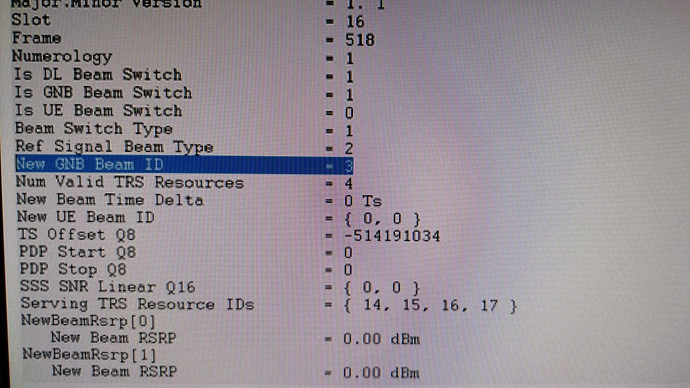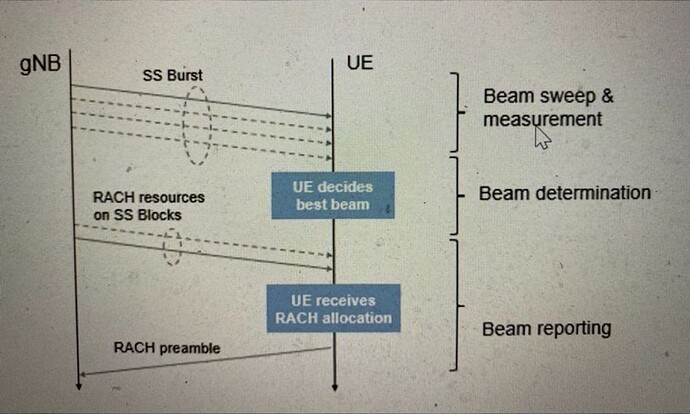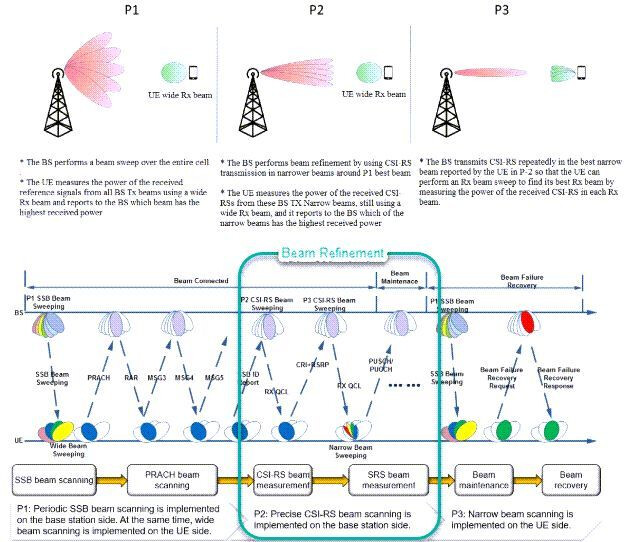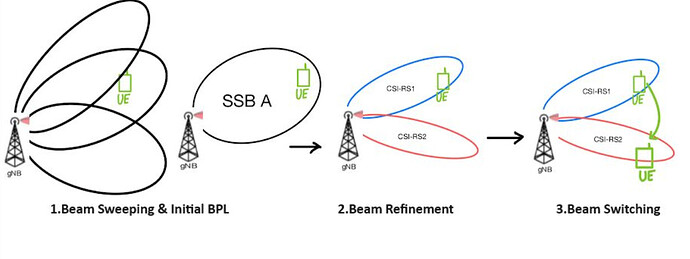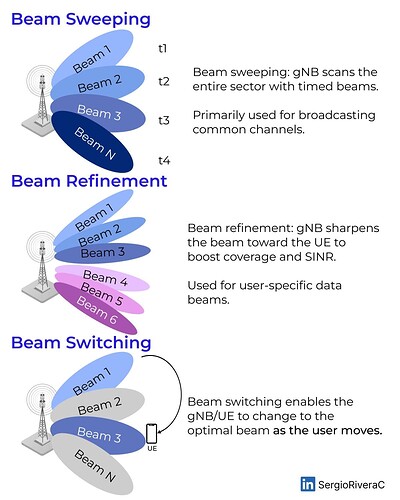This is what you are looking for when there is a TCI change: MAC DL TB Report
Very clear here for your case  .
.
@marcengo, could you please share snap of B9B9?
I don’t have it…
Just observation… No reference yet.
Thanks @marcengo! 
One final Question, which @RFSpecialist asked earlier:
When we have SSB RSRP and CSI-RSRP in same MAC CSF info as Record 0 and record1, how can we know (If at all UE don’t know) the beam switching will be for CSI-BEAM or SS Beam?
Sample CSF message here:
Chipset timestamp: 2020-03-20 19:37:27.447903, CFN : 87
Dual Mode Index : 0
SIM Index : 255
Version : 65537
Major.Minor Version : 1.1
log_fields_change
log_fields_change_bmask : 0x0000
sub_id : 0
num_records : 3
Records
Record[0]
report_ul_time
slot : 14
numerology : 120kHz
frame : 713
carrier_id : 0
report_id : 2
report_type : APERIODIC
num_bits_part1 : 35
num_bits_part2 : 0
is_rsrp : RSRP
num_bits_part2 : 0
debug_only : Result_from_WP
report_quanlity : RSRP , SSB_INDEX
resource1 : 8
resource2 : 7
resource3 : 5
resource4 : 4
resource_type : SSB
num_resource_bits : 4
pad : 0
rsrp1 : 53
rsrp2 : 47
rsrp3 : 47
rsrp4 : 46
valid_rsrp : 4
Record[1]
report_ul_time
slot : 14
numerology : 120kHz
frame : 713
carrier_id : 0
report_id : 0
report_type : APERIODIC
num_bits_part1 : 10
num_bits_part2 : 0
is_rsrp : RSRP
num_bits_part2 : 8
debug_only : Result_from_WP
report_quanlity : CRI , RSRP
resource1 : 5
resource2 : 0
resource3 : 0
resource4 : 0
resource_type : CSI_RS
num_resource_bits : 3
pad : 0
rsrp1 : 55
rsrp2 : 0
rsrp3 : 0
rsrp4 : 0
valid_rsrp : 1
Record[2]
report_ul_time
slot : 14
numerology : 120kHz
frame : 713
carrier_id : 0
report_id : 1
report_type : APERIODIC
num_bits_part1 : 10
num_bits_part2 : 0
is_rsrp : RSRP
num_bits_part2 : 8
debug_only : Result_from_WP
report_quanlity : CRI , RSRP
resource1 : 5
resource2 : 0
resource3 : 0
resource4 : 0
resource_type : CSI_RS
num_resource_bits : 3
pad : 0
rsrp1 : 63
rsrp2 : 0
rsrp3 : 0
rsrp4 : 0
valid_rsrp : 1Each of these records have a different report_id, so, different purposes.
Once you track it to the RRC message which did set-up the events, you will have an idea of what it is aimed for.
Like this part from bullets.
For CSI reporting, you can have NZP CSI RS for channel measurements (my take, this is where you will do refinement, I didn’t get to this part on my studies yet), NZP CSI RS for interfere measurements and CSI IM also for interference measurements.
It’s correct, channel measurement is main point here.
Without refined beam.
Seems the issue is with my tools before.
Thanks gent for the discussion…
Finally I found it now 
EQ1
NR 5G MAC DL TB Report
Time : 13:06:39.953
Length : 48
Log Code (Hex) : 0xB886
HW Timestamp : (36359385.00 ms) 10:05:59.385
Version : 65539
Log Fields Change
Sleep : 0
Beam Change : 0
Signal Change : 0
DL Dynamic Cfg Change : 0
DL Config : 0
UL Config : 0
ML1 State Change : 0
Log Fields Change BMask : 0x0000
Num Records : 1
Records :
[0 ] :
System Time
Slot : 9
Numerology : 1
Frame : 26
Number of Active Carriers : 1
Per Slot PDSCH logging :
[0 ] :
Carrier Id : 0
MCE Bitmask :
TCI_STATE_IND_UE_PDCCH_MCE
TCI State PDCCH
number of cc : 1
cc info :
[0 ] :
Serving Cell Id : 1
Coreset Id : 1
TCI State Id : 2
CC Id : 0If you see cri-RSRP on the reportQuantity, then…

I’d say, from a purely UE perspective, it will be hard to say it 100% what is the goal, you will likely to require some vendor info as well.
Or guess based on what happens after the report, beam change, mobility, etc…
Layer 3 rsrp based on CSI channel measurement.
Layer 1 rsrp based on CSI-RS beams.
Question:
- UE is in idle mode
- Initial access using ss beam done
- UE went to connected mode got a CSI-RS beam for data transmission
Will SS-beam be released after point3?
Or
Will UE report ss rsrp and csi rsrp during this connected mode also?
Yes, UE will report RSRP in connected mode as well.
For SSrsrp at L3 for cell change.
For SSrsrp at L1 for intra cell beam mobility.
Beamforming and Beam Management concepts plays a major role in 5G NR.
-
In idle mode beamforming is assisted by PSS, SSS, PBCH (SS Block) and DMRS.
-
In connected mode , CSI -RS is utlized to assist beamforming in the downlink and SRS in the uplink.
For the beam management in 5G NR we have four step process to know.
- Beam Sweeping
- Beam Measurement
- Beam Determination
- Beam Reporting
Additionally we can add Beam Recovery and Beam Switiching as well as a part of beam Management.
Beam refinement is a special procedure.
Beam refinement is important after UE get access to network and establishment RRC Connection i.e. after SSB sweeping UE latch to network, there can be special need for optimal transmissions as radio conditions are undergoing Continous changes so radio channel which may was occupied in start or during radio connection ; is no longer best for UE.
Thus, it needs to undergo continuously beam refinement where include adjustment of the Beam from UE and BTS side.
In 3gpp Beam refinement is divided in to two procedures P2/P3 (i.e., refinement from BS(DL) and UE (UL) side, respectively.
Beam correspondence may always be prone to varying due to radio condition changing due mobility or other reason or UE capability issues like power limitation. That’s why beam refinement is always required to maintain such beam correspondence.
Beam refinements are performed in these high lighted steps in figure below.
LinkedIn: Sign Up | LinkedIn
ShareTechNote: 5G | ShareTechnote
Hi fazlee,
Do you mean that beam refinement is periodic in UE mobility case and can I think this as the SSB beam sweeping and CSI-RS refinement are periodic in connected mode? such as the SSB burst still occupies 5ms of 20ms and transmitted periodically such as 20ms?
Thanks a lot
Nop, both can be based on SS-RSRP too.
This post aims to simplify the fundamentals of Beam Management in 5G.
-
Process 1: Beam Sweeping
SSB Broadcasting: gNB sends SSBs wide beams across the cell with unique IDs.
Initial Beam Selection: UE picks the best SSB based on RSRP in Idle Mode.
Contention-Free RACH: UE performs RACH on the chosen SSB, uniquely linked to an RO.
Beam Pair Linking (BPL): UE’s Tx beam is chosen based on the received Rx beam for MSG1. gNB monitors Rx beam, establishing Downlink and Uplink BPL.
Result: UE and gNB form a broader beam link for initial data transfer.
Note: Beam Sweeping is mainly used for Common channels. -
Process 2: Beam Refinement
Refining for Precision: The beam is refined from a broader SSB to a narrower CSI-RS for precise control, ensuring accuracy in data transfers.
Narrower Beam Generation: gNB creates narrower beams within the SSB, linking each to unique CSI-RS resources. Example: SSB beam A maps to CSI-RS 1 and CSI-RS 2.
Measurement and Switching: UE measures CSI-RS for each narrower beam, sending a report.
Result: The initial SSB beam switches to the most suitable CSI-RS, leading to improved SNR and overall throughput. -
Process 3: Beam Switching
RRC Reconfiguration: gNB informs UE of future Tx beam changes using assigned TCI ID and CSI-RS beams.
UE Configuration: gNB configures UE with TCI states linked to various beams (e.g., CSI-RS1 with TCI 1).
Measurement Reports: UE periodically sends CSI-RS reports to gNB, including beam-specific measurements.
Switching Beams: If conditions worsen for Beam 1, gNB switches from CSI-RS1 to CSI-RS2 based on received reports.
Result: UE switches to best serving beam based on CSI-RS measurements.
LinkedIn (source): ![]()
Beam Management in 5G
Beamforming allows gNodeBs to generate multiple narrow beams, dramatically improving coverage and capacity.
But how does the network ensure the right beam reaches the right UE?
Here’s a high-level overview of the three key components of Beam Management:
![]() Beam Sweeping
Beam Sweeping
Used mainly for common signals (paging, system info, random access), beam sweeping ensures that every UE in the coverage area receives at least one beam carrying this essential information. The gNodeB scans the entire sector by transmitting beams in different directions sequentially, like a lighthouse covering all angles.
![]() Beam Refinement
Beam Refinement
Once a UE is detected, the network refines the beam, from wide to narrow, focusing precisely on the UE’s location. This improves SINR and is key for delivering UE-specific data with better range and performance.
![]() Beam Switching
Beam Switching
As the UE moves or the environment changes, the gNodeB seamlessly switches traffic from one beam to another, maintaining connectivity and service quality.
Beam Management is what enables 5G to deliver high-speed, reliable communication even in challenging environments.
LinkedIn: ![]()
